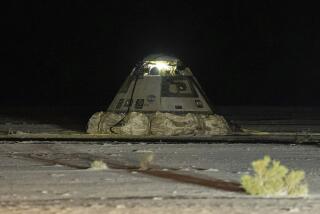NASA’s workhorse about to retire on Mars
The death watch is on for NASA’s Phoenix lander, the first spacecraft to sample water on another planet.
Buffeted by dust storms and chilled by temperatures as low as minus-141 degrees Fahrenheit from the impending arrival of the Martian winter, Phoenix is clinging to life, but barely, NASA officials said Friday.
“We knew this was coming,” said project manager Barry Goldstein. “It’s bittersweet.”
Days earlier, Phoenix fell silent, going into safe mode to save battery power. After failing to answer to two wake-up calls from Earth, it flickered back to life long enough Thursday to send a signal to the Mars Odyssey spacecraft orbiting overhead. It then went back to sleep for another 19 hours to recharge its batteries.
The lander, however, failed to awaken from its latest sleep Friday, alerting NASA officials to the possibility that the end could be very near. “It’s going down the way we expected,” Goldstein said.
He said mission officials would keep watch over the weekend to see if it revived again.
Phoenix, which landed May 25 on the northern Martian plains, has already survived two months longer than its planned three-month mission. But with the sun sinking lower in the northern sky, the solar panels that power the craft’s instruments can’t draw as much power. A dust storm this week also applied a fine coat of Martian soil to the solar panels, further limiting their ability to produce electricity.
NASA officials said they hoped to keep the lander alive a few more weeks, to squeeze every last bit of science out of it before it descends into a sleep from which there will probably be no waking. To conserve power, ground controllers plan to shut down four heaters that keep the lander’s main instruments warm enough to operate.
“If we did nothing, it wouldn’t be long before the power needed to operate the spacecraft would exceed the amount of power it generates on a daily basis,” Goldstein said.
The first heater to be shut down is connected to the 7-foot-long robotic arm that dug up the first samples of ice analyzed on an alien world. That heater also warmed the thermal and evolved-gas analyzer, or TEGA, which contained eight ovens used to bake and sniff the soil samples dug up by the robotic arm.
The arm and the TEGA instrument make up the heart of the lander’s instrument package. They were designed to answer the central question of the $420-million mission: Could Mars be habitable for some types of simple life forms?
That question will probably remain unanswered, since TEGA did not find any organic compounds that are the basis of life as we know it on Earth.
“We turn off this workhorse with the knowledge that it has far exceeded expectations and conducted every operation asked of it,” said Ray Arvidson, a lead scientist for the craft’s robotic arm.
Although it failed to prove that Mars could or could not harbor life, Phoenix did rack up a significant list of accomplishments. Besides digging into the layer of ice lying inches under the lander, it uncovered evidence that the ice could have melted at some point, thus filling in missing gaps in the planet’s unfolding water story.
The lander’s onboard chemistry lab found that the soil is much more hospitable than many scientists had supposed. As opposed to the popular view that Martian soils are too acidic to support life, Phoenix found that it is more alkaline than acid.
“You might be able to grow asparagus very well,” a mission scientist said in June.
As winter descends, controllers will disable heaters that warm the lander’s main camera and the meteorology station that monitors Martian weather.
After a fourth heater that warms the batteries is turned off, “Phoenix will be at the mercy of Mars,” said Chris Lewicki, a mission manager at the Jet Propulsion Laboratory in La Canada Flintridge.
Phoenix could spring back to life with the next Martian summer, but mission scientists say they are not counting on it.
--
More to Read
Sign up for Essential California
The most important California stories and recommendations in your inbox every morning.
You may occasionally receive promotional content from the Los Angeles Times.










